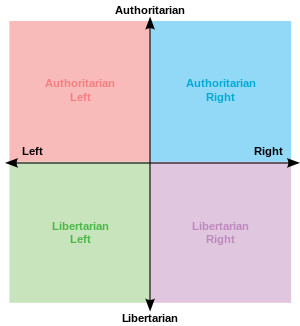The Political Compass
This article needs additional citations for verification. (February 2008) |

A political compass or political diamond is a multi-axis model used to label or organize political thought on several dimensions. There are several competing political compasses, with varying number of axes.
Overview
A similar illustration appeared in Floodgates of Anarchy;[1] however, the term "Political Compass" was first used by a website[2] which runs an online questionnaire that will rate political views on two axes: Economic (Left-Right) and Social (Authoritarian-Libertarian). The site also includes an explanation of the two-axis system they use, a few charts which place various past and present political figures according to their estimation, and reading lists for each of the main political orientations.
The underlying principle of the Political Compass is that political views may be better measured along two separate and independent axes. The Economic (Left-Right) axis measures one's opinion of how the economy should be run: "left" is defined as the view that the economy should be run by a cooperative collective agency (which can mean the state, but can also mean a network of communes), while "right" is defined as the view that the economy should be left to the devices of competing individuals and organisations. The other axis (Authoritarian-Libertarian) measures one's political opinions in a social sense, regarding a view of the appropriate amount of personal freedom: "libertarianism" is defined as the belief that personal freedom should be maximised, while "authoritarianism" is defined as the belief that authority and tradition should be obeyed.
The labels given to the different fields and axes on the compass are based on long-standing European and Commonwealth terminology. Some of those labels are used differently in the politics of the United States, which may confuse some American visitors to the website, although most of these terms are explained as they are used.
See also
| Part of the Politics series |
| Party politics |
|---|
|
|
- Political spectrum - discusses the dimensionality concept at length
- Nolan Chart
- Pournelle chart
References
- ^ Meltzer, Albert (1970). Floodgates of Anarchy. ISBN 0900707038.
{{cite book}}: Unknown parameter|coauthors=ignored (|author=suggested) (help) - ^ "Political Compass".
{{cite web}}: Cite has empty unknown parameter:|coauthors=(help)
